The
Ipswich coat of arms, and other crests
Above: an illustrated version of the coat of arms as it appears
on the first page of Ipswich
in 1912: King Edward Memorial Sanatorium EADT Souvenir
(available from this website as a PDF download). See
also Ipswich
Sanatorium on our Hospitals page.
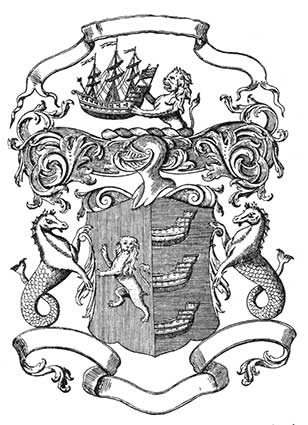
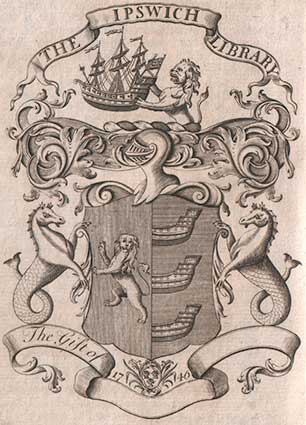
Above left: the original borough arms, which probably date from
1200
when King John granted Ipswich its Charter, consisted only of the
shield with a rampant lion in gold on a red field and three demi-ships,
also in gold, on a blue field. The arms are as confirmed by William
Hervy, Clarenceux King of Arms in 1561, when he granted the supporters
in silver and the crest surmounted by a demi-lion holding a ship.
Above right: the same arms with additions on a donation plate to
the Ipswich Town Library dated 1746, taken from the book An account of the gifts and legacies that
have been given and bequeathed to chatitable uses in the Town of Ipswich,
1747. These bookplates would have been pasted inside
each donated book.
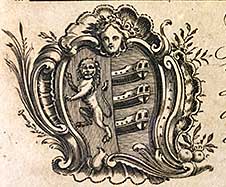
Above: the coat of arms as it appears on the Buck brothers' Prospect
of Ipswich 1741.
This heraldic emblem crops up in several places in the town.
Architects clearly thought that it was an appropriate addition to some
of the building fascias; either that or the person paying the bill
specified the addition of the coat of arms. If you know
of any other examples in Ipswich, do email us.
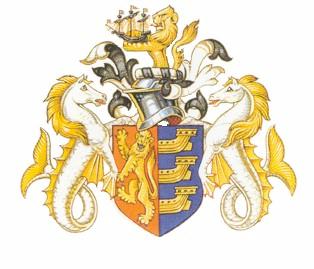
Official blazon
Arms: Per pale Gules and Azure
in the first a Lion rampant Gold armed and langued Azure in the second
three demi Boats of the third.
Crest: On a Wreath Or and Gules
a demi Lion Or supporting a Ship Sable.
Supporters: Two Horses of the
Sea commonly called Neptune's Horses maned and fined Gold.
Origin/meaning
The arms were officially granted on August 29, 1561. The arms are based
on the arms of the Cinque Ports (scroll down to the Tavern Street
entry), the five harbour
towns that were supposed to provide support for the Royal Navy for
several centuries. The common arms of these cities were English lions
with ship-hull tails.
A ship appears on a 13th century rope seal:
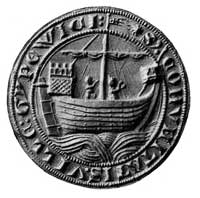 13th Century Seal of Ipswich
13th Century Seal of Ipswich
Several months after the granting of Ipswich’s charter in May
1200, the town’s newly-formed government designed a town seal. The two
rope seals are still kept at Ipswich Town Hall on Cornhill, along with
the Town Mace and Sword (see the following entry: St Mary-Le-Tower).
Depicted
on it is a Man o’ War vessel with castles fore & aft, it is not so
very different from the small coastal vessels that would have been in
use by the Ipswich merchants of that time. It is possibly an early
representation of the collier ships that would, in future centuries,
become known as ‘Ipswich Catts’. However, many now agree that it is a
'Cog', a cargo ship particularly used by Hanseatic merchants – Ipswich
being a Hanseatic port. But what is most interesting about the
design, is that many claim that it is the first known example anywhere
in the world of a ship with a movable
rudder, as
opposed to a steering oar commonly in use during that era. (The
reverse of the seal depicts the Church of St Mildred on the Cornhill,
which would eventually become the town’s court & Town Hall, later
destroyed.)
The
depiction of the ship hulls on the Ipswich coat of arms varies
according to period and punctilliousness of the designer. The three
hulls sometimes show some sort of rudder. Around the
circumference of the seal are characters. Louis Musgrove tells us that
he thinks the inscription is: SI(GILLUM) COMUNITATIS VILLE
GYPEWICI' or in English: 'The master seal of the town of
Ipswich'.
The 'Horses
of the Sea' or 'Neptune's horses' also vary on the coats of arms shown
here; sometimes they have
realistic horse heads, sometimes they are much more like zoological
sea horses. Their front hooves become webbed claws. One
writer has described the supporters of
the Ipswich arms as wyverns, but a wyvern is described elsewhere as a
"winged two-footed dragon"and we do not see a dragon head, nor wings.
Corn Exchange Grand Hall roof
At the apex of the roof supports inside the Corn Exchange, pierced metalwork scrolls
with olives and leaves surround the central circle featuring a version
of the lion rampant holding a sailing vessel from the Borough coat of
arms. The extended tongue, flaming mane and whiplash tail all
contribute to a dynamic – and rarely noticed – motif. One can only
imagine the painter on top of a scaffolding tower putting the finishing
touches to this gilded wonder.

Alexandra Park opening: ceremonial key
 Image
courtesy Peter Wonson
Image
courtesy Peter Wonson
For more details see our Alexandra
Park page.
The Mayor's parlour
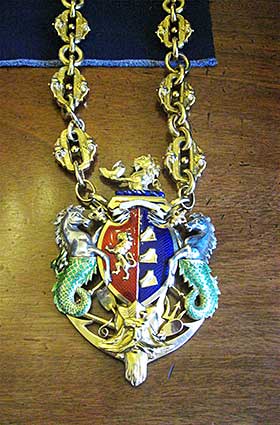 2018 images
2018 images
The Mayor of Ipswich has a fine enamelled chain of office
featuring a version of the town's coat of arms against an anchor and
other maritime motifs; even the actual chain echoes a ship's anchor
chain in design. Such was the importance of international trade by sea
via Ipswich docks to the wealth of the town.
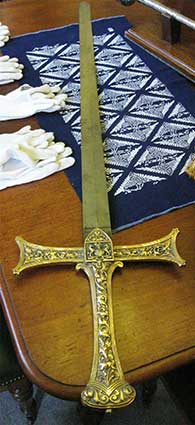
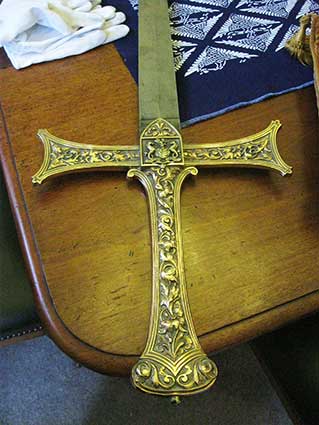
The Town Sword is a Victorian addition to the ceremonial armoury
with brass handle and decorated steel blade. It
commemorates the Golden Jubilee of Queen Victoria on 20 June 1887 on
the occasion of the fiftieth anniversary of her accession in 1837.
The two Town Maces are the gift to Ipswich of Charles II
(reigned from 1660 until 1685), but do not bear the town's insignia.
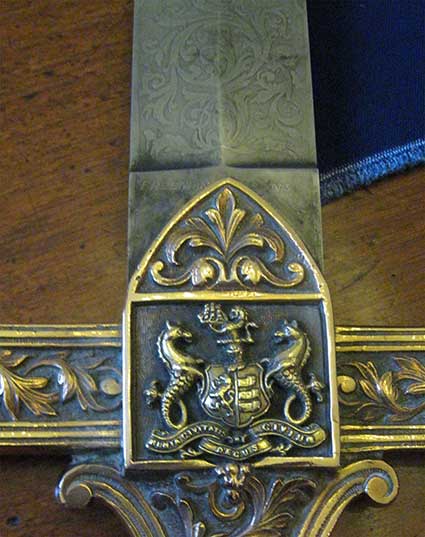
The motto on the scroll is: 'MUNIA CIVITATIS DECUS CIVIUM' ('The
functions of citizenship are the glory of the citizens'). It also
appears on the coat of arms on the Ipswich Art School (see below).
Church Congress
banner, 1927
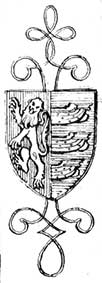 Shield with the arms of the Borough of
Ipswich.
Shield with the arms of the Borough of
Ipswich.
Ogilby map 1674
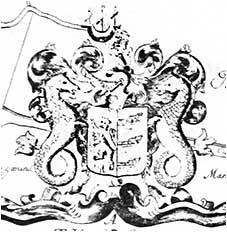
Ceramic Zeppelin sold by Woottons
of Ipswich
 Image courtesy Taff Gillingham
Image courtesy Taff Gillingham
One of the oddest uses of the Borough coat of arms is Woottons ceramic Zeppelin souvenir.
Bookmark
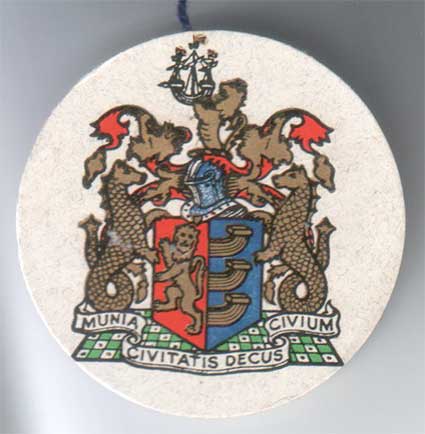 1932
1932
The above circular bookmark on its blue cord is
part of the Ipswich: an ideal
industrial centre
promotional book published by Ipswich Borough in 1932 (see below).
1932 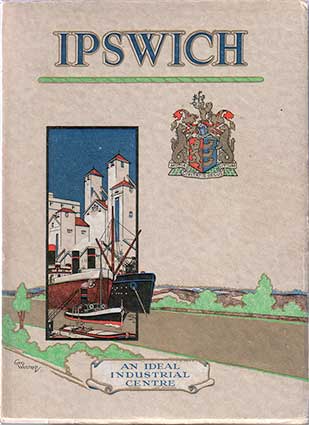
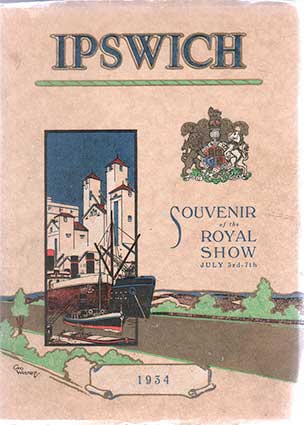 1934
1934
1932 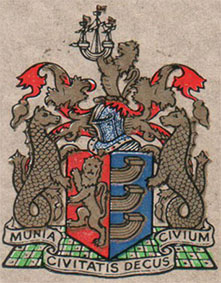
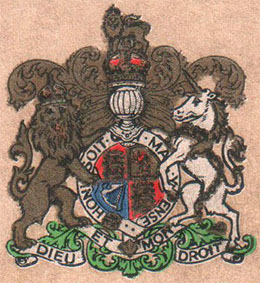 1934
1934
The admirable
illustrated cover shows the towers of Cranfield's flour mill on Albion
Wharf on the northern quays of the Wet Dock with cargo vessels in the
foreground. There's a lot of gold ink on the cover,
particularly the strip of the river which runs from left to right –
perhaps suggesting the trading value of the Orwell to Ipswich. The
signature is 'Geo Westrip'. The cover carries another version of
the Borough coat of arms. The bookmark carries the coat of arms,
presumably by the same illustrator, on both sides. This book has many
photographs of trades, manufactories and places of work along with
advertisements and passages in German and French to emphasise the
international nature of Ipswich trade (we include selections from these
on various pages on this website). Compare this with Ipswich: souvenir of the Royal Show July
3rd-7th, 1934. Clearly recycling is nothing new. Two years
later, about 85% of the content, along with the covers, were reused for
this souvenir of the Royal Show, held
on the fields across the main road from Chantry Park (long before the
present housing was built). On this cover the Borough arms are replaced
with the 'lion and unicorn' Royal Arms. One hopes that the illustrator
got an extra fee, but it's doubtful... The rather slapdash application
of gold ink on the Royal Arms tends to obscure/obliterate detail.
Ipswich Buses 120th anniversary.
'Proudly serving the people of Ipswich for 120 years'
 2025
image
2025
image
1906 Guide book
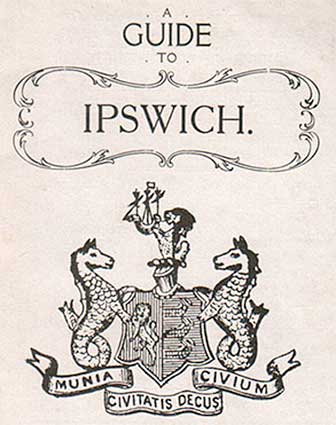 1906
1906
A small format Guide to Ipswich published in
1906 featured this slightly odd version of the coat of arms.
'County Borough of Ipswich'
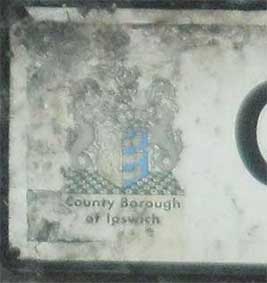
The ghostly coat of arms bearing this pre-1974-reorganisation
name appears on our Civic Drive page.
The Post Office
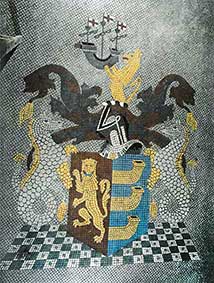
Long locked away from the public gaze, here's the old Post
Office floor mosaic.
St Mary-Le-Tower
The Civic Church of the Town is St Mary Le Tower in Tower
Street, the churchyard of which became the earliest meeting-place for
townsmen and Portmen after the granting of the 1200 Charter by King
John. Its interior contains decorative and heraldic elements on the
Town Mace and Sword furnishings which
relate to the Ipswich coat of arms.
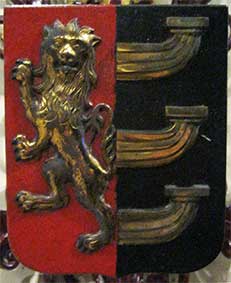
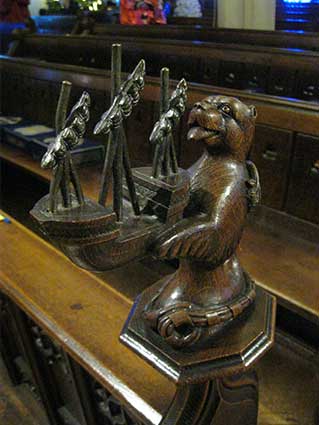
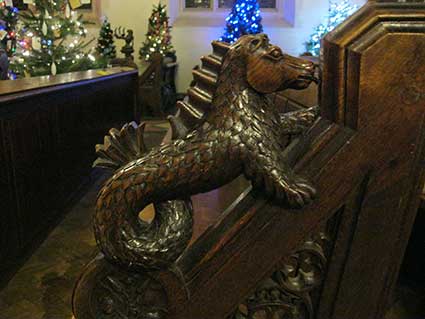
Above: Town crest, Lion holding ship and Neptune's
horse.
40 Museum
Street
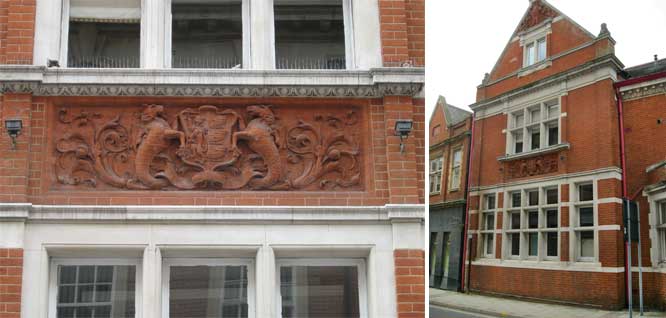
An elaborate terra cotta rendition of the Ipswich civic
heraldry (it lacks the half-lion holding the ship at the top, probably
because of the space available). The nose on the left hand sea horse
has broken off. This was
a Customs & Excise building at one time.
The Public Sculpture of Norfolk & Suffolk
database (see Links) tells us:
"The panels set between the windows
show the Ipswich coat of arms supported by wyverns and set between
foliage. In the other panels the foliage supports a central vase.
Customs and Excise were only combined in 1909 - which must be the date
of the present building. The coats of arms serve as a reminder that it
was a National Service but that this branch was based in the Port of
Ipswich. Customs and Excise was merged with the Inland Revenue in 2004."
To the right of this coat of arms, at number 38, "The curved pediment
of the doorway is decorated with a striking royal coat of arms with a
fierce lion. The panels set between the windows show the Ipswich coat
of arms supported by wyverns and set between foliage. In the other
panels the foliage supports a central vase. On royal coat of arms:
'DIEU ET MON DROIT [and]
HONI SOIT QUI MAL Y PENSE'
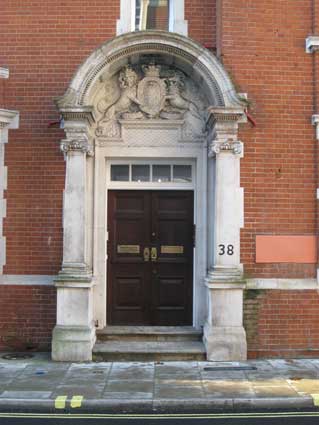
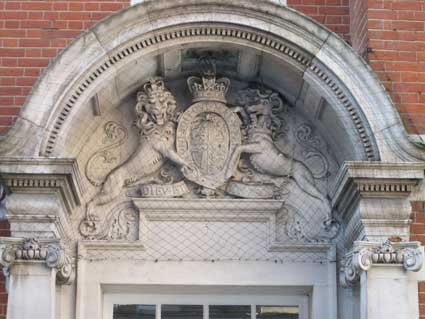 2013 images
2013 images
A similar (very faded) royal coat of arms can be found on the
side wall of the court in nearby
Arcade Street:
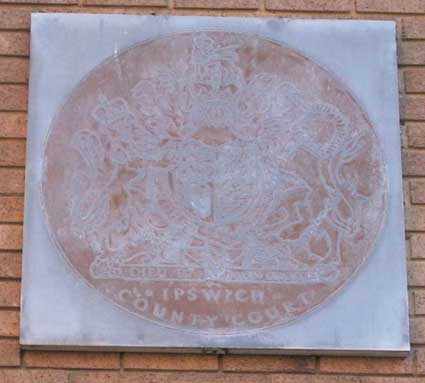 'IPSWICH COUNTY COURT'
'IPSWICH COUNTY COURT'
An employee of a private security firm stopped any further
photographs because "You're not allowed to photograph Government
buildings".
Café Nero, 52-54 Butter Market
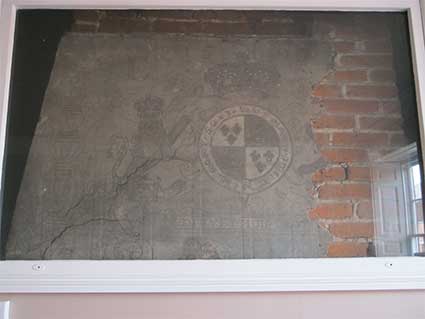 2018
images
2018
images
Another royal coat of arms is tucked away behind a chimney
breast on the first floor of the Café Nero building (officially 54
Butter Market, but with a substantial part on Upper Brook
Street). We were tipped off about this by a gentleman at the
Masonic Lodge in Soane Street on Heritage
Open weekend 2018.
'1593
E ...
HONI SOIT QUI MAL Y PENSE [inside an Order
of the Garter circle]
DIEU ET MON DROIT'
Our photograph shows the
remaining part of the painted plaster; but why the ragged edge to the
right which would have included the 'R' of 'ER' (Elizabeth Regina)?
The descriptive text in a small frame beside it is shown below.
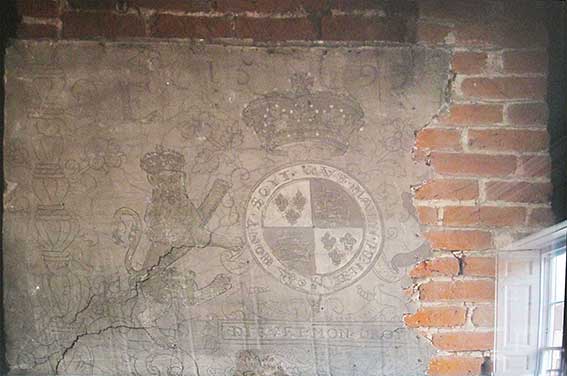
'The Hacked-off Dragon Cafe. Given the date on this royal coat
of arms of 1593 it must have been drawn during the reign of the last
Tudor monarch, Queen Elizabeth the First. It is interesting to note
that it does not however bear her personal motto of "Semper eadem" or
"always the same". The Tudor coat of arms would have had a dragon as
the supporting heraldic beast. It seems likely that it was removed on
Elizabeth's death in 1603 and for whatever reason the Stuart unicorn of
King James VI of Scotland was never added in its place when he became
James I of England.
J. Huw Evans, Author, Poet, Wit and Sage 2013'
As yet, we have been unable to ascertain why this partial coat
of arms is attached to the brickwork on "the 1900 building" which is
featured on our Symonds for Kodak page.
Was this an original feature of the building before the 1900
terracotta facade was built, or was it rescued from elsewhere and moved
here? We think we should be told.
Mystery crest, Park Road
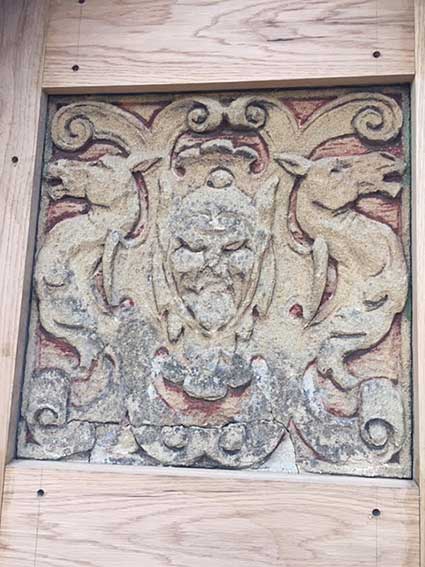
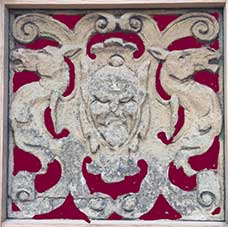 2019
images courtesy Simon Farr
2019
images courtesy Simon Farr
[UPDATE 30.6.2019: ‘Dear
Borin, I wonder what you might have to say about this ‘Coat of arms’ if
you would call it that. This is on the stables building, top of
Christchurch Park in Park Road, which my wife and I are currently
restoring and developing. According to the park souvenir guide by David
Miller, the building was designed by John Shewell Corder. It seems to
be in carved sandstone. The relief
has the sea horses as in the Ipswich coat of arms, but facing the other
way, and the face of maybe Neptune or maybe even the devil! Any
thoughts? (I’m going to restore it with a bit of red, like attached).
Simon Farr.’ Many
thanks to Simon for send this mystery crest. We're not sure that these
horses' heads/necks qualify as 'Neptune's horses' and they are rendered
in quite a dynamic way unfamiliar in heraldry, as is the fact that they
face outwards. Of course, a stable-block would be a suitable location
for a crest featuring horses. The central face resembles something on
the cover of a Dennis Wheatley novel – the supernatural author from the
1960s – in other words, rather demonic. If anyone can add any information about
this tucked away crest, which appears to have had a red-coloured background, please click the
'Contact us' link at the foot of the page.]
Masonic Lodge, 8 Soane Street
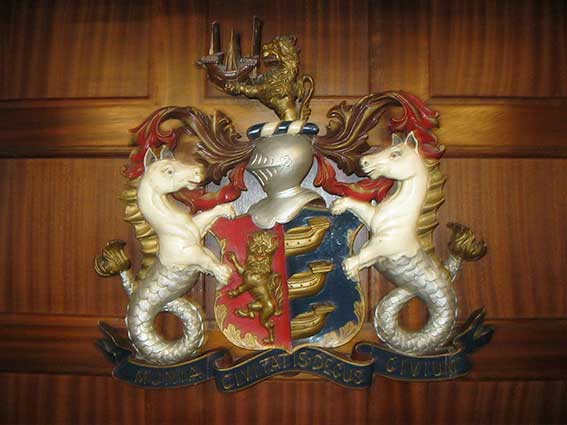 2018 image
2018 image
See our Soane Street page for more
information about the building and the site of the coat of arms.
The Christchurch Park cenotaph
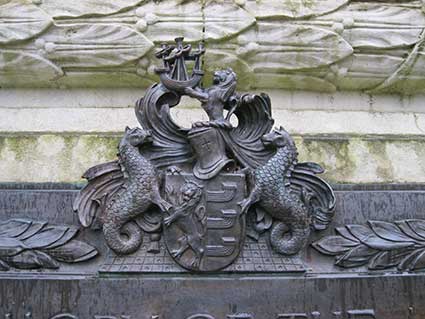
A fine piece of metalwork on the reverse face of the cenotaph in
Christchurch Park shows the Town coat of arms in three dimension,
rising from a chequerboard base.
Ipswich Crematorium
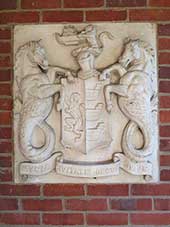 Next to the Temple of Remembrance, Ipswich 'New
Cemetery'.
Next to the Temple of Remembrance, Ipswich 'New
Cemetery'.
Old
cemetery gates, Cemetery Road
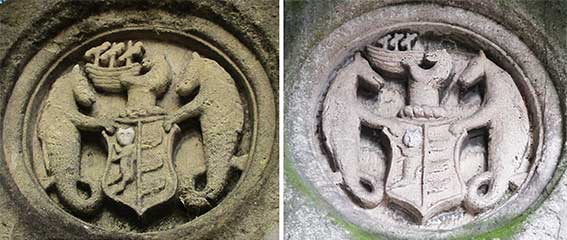 2022
image
2022
image
Ipswich School
While unrelated to the town's coat of arms, this strikingly odd
coat of arms can be seen on a modern extension to The Ipswich School in
Ivry Street. In fact it turns out to have rather more
regal origins.
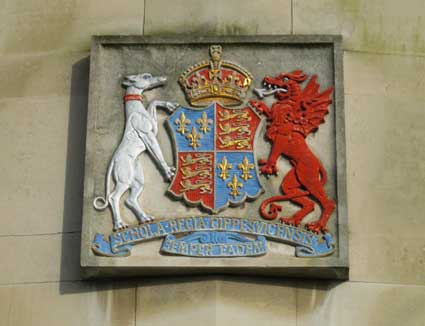 2014
image
2014
image
After Cardinal Thomas Wolsey’s downfall in 1530, Thomas Cromwell
ensured the survival of the School by securing for it a new endowment
from King Henry VIII and the status of a royal foundation. This was
confirmed by Queen Elizabeth I in the royal charter that she granted to
the School in 1566. For part of the School’s history it was known as
Queen Elizabeth’s Grammar School, Ipswich. The school's coat of arms
and motto, 'Semper Eadem' (Latin for 'Always the same'), are those of
Elizabeth I. The upper scroll reads:
'SCHOLA REGIA
GIPPESVICENSIS'
(Latin for 'King's School of Ipswich'). See our
pages on Christ's Hospital School
and Wolsey's College for further
information.
Town Hall
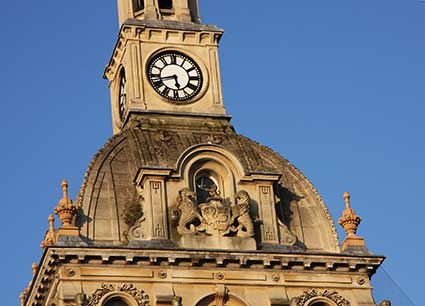
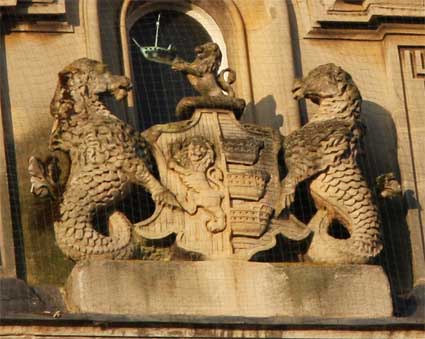 Photograph
courtesy JohnNorman
Photograph
courtesy JohnNorman
The pediment on the cuploa of the Venetian Gothic Town
Hall (1868) bears a variant of the coat of arms – in fact each version
is slightly different, depending on the sculptor and commissioner. Here
the very scaly Neptune's horses support the crest, but the royal lion
above does not sprout from an armoured helmet, but from a small
platform (possibly easier to sculpt). The ship held by this lion is
made of copper, now green with oxidation. The lack of helmet recurrs on
the Mayor's Chain of Office, on Dogs Head Street, the County Library,
the Custom House and elsewhere. Neptune's horses are the features which
seem to have been constantly reinterpreted by designers.
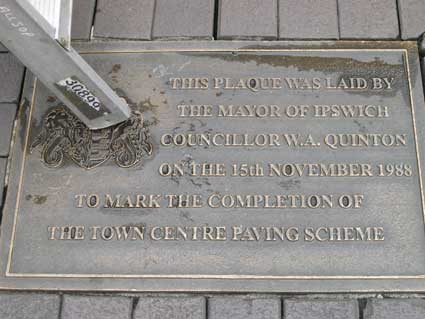 2014 image
2014 image 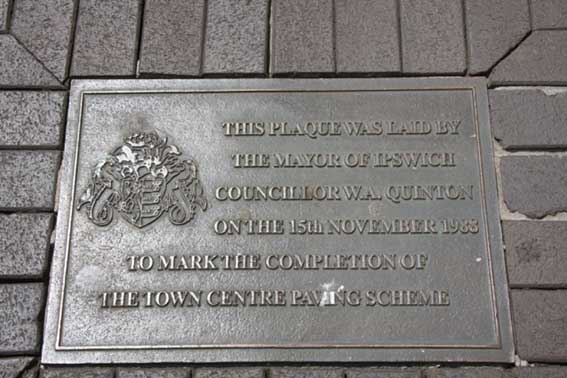 Courtesy
John Norman
Courtesy
John Norman
On the Cornhill paving, in front of the Town Hall
entrance is a ground-level metal plaque bearing the Ipswich coat of
arms. When this July 2014 photograph (left) was taken the crest was
rudely
covered by a step-ladder foot tied to a market stall; see our Cornhill
page for an uncluttered image. Oddly, Bill Quinton was once again Mayor
of Ipswich at this time. John Norman's image (above
right) shows the coat of arms and the damage caused by the metal.
With the repaving of the
Cornhill in 2018/19, this plaque doesn't seem to have been replaced. Compare with similar plaques on Common Quay, in front of
the Custom House, outside the former Martin & Newby shop in Fore Street.
Corn Exchange
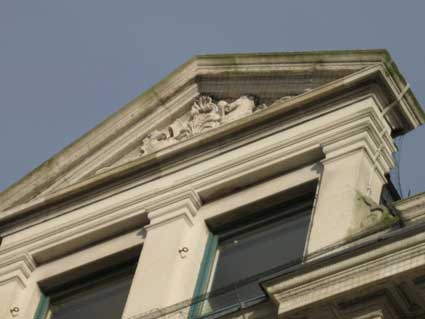 2013 image
2013 image
The above image shows a variant of the Ipswich coat of arms
which seems to feature a sheaf of corn between the 'sea horses' and a
scallop shell at the top. It is to be found high up above King Street and one would need to view it
from the upper window of a nearby building. [UPDATE 30.7.2018: The photograph
below was taken from the roof of Mutual House.]
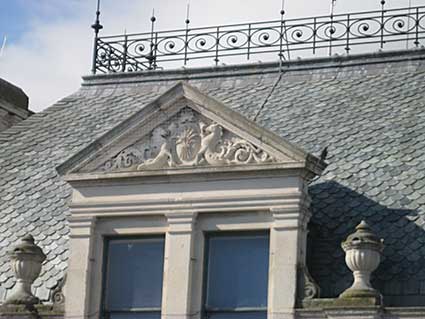 2018 images
2018 images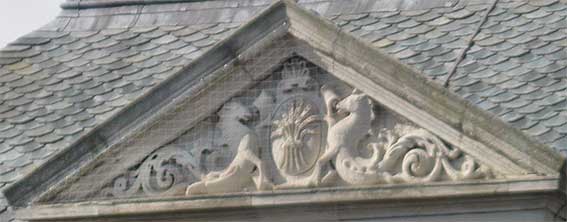
Below: two views of the
coat of arms above the upper part of Princes
Street.
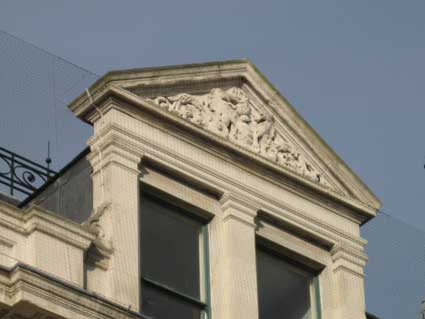
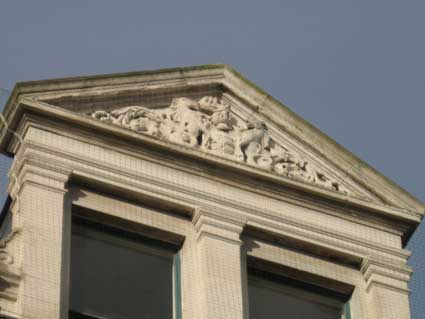 2013 images
2013 images
Inside the Corn Exchange is a fine
carved wood example, highlighted in gold:
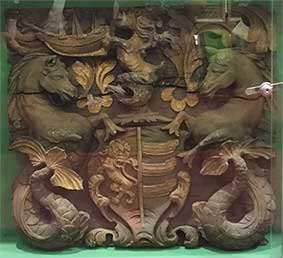
Central Post
Office
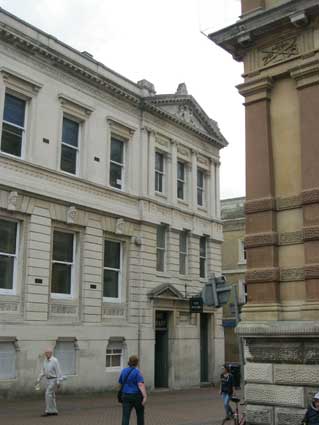
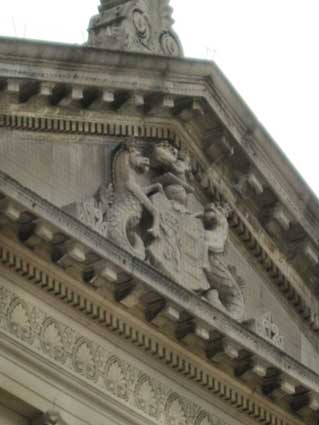 2013
images
2013
images
Perhaps a puzzling one, this. At the side of the central Post
Office building, running down the top of Princes Street, a palladian
triangle carries a carved stone coat of arms which is really only fully
visible from the windows of the gallery which used to be called 'The
Library' in the Town Hall.
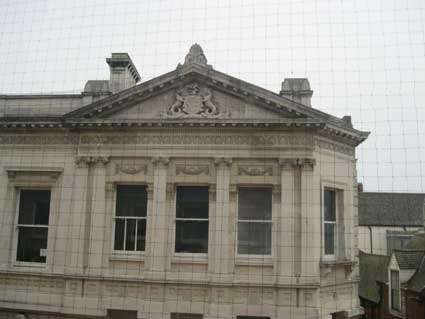
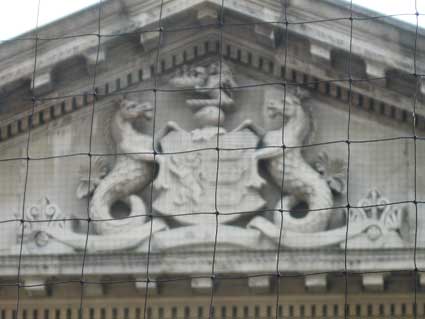
Tavern
Street
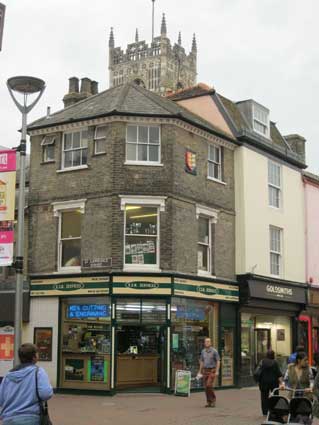
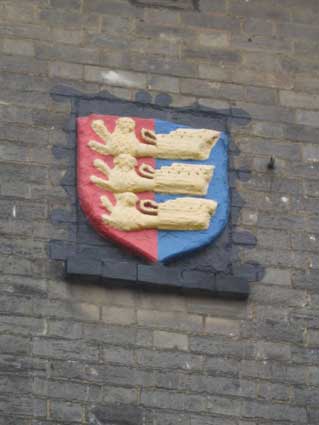 2013
images
2013
images
Why are the Arms here?
On the second story of the shop on the corner of St Lawrence Street and
Tavern Street, with St Lawrence
Chuch in the background, is set a relief version of the
town's arms,
picked out in bright colours. However, the single lion
rampant has been replaced by three half-lions which exude from the
three ships' sterns. In the words of David Allen in a
Suffolk Institute paper: 'The conduit stood on the corner of Tavern
Street and St Lawrence Street, its position commemorated today by a
plaque of the arms of
the Cinque Ports (on which the Town coat of arms is based – see
top of this page) on the wall of no. 44 Tavern Street, which
stands on the site of an earlier property known as the Conduit House.
Its citing as a landmark in 1395 suggests that it was by then a
well-established feature.' Compare with: 'The
conduit stood at the western junction of Tavern Street with St Lawrence
Street, its former presence still indicated by the Town Arms over the
corner premises.' (Clegg, M.: Streets
and street names in Ipswich, see Reading
list). For more on the naming of St Lawrence Street see the St Lawrence
Church page).
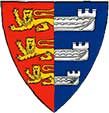 Cinque
Ports coat of arms
Cinque
Ports coat of arms
See our Water in
Ipswich page for the David Allen citation.
Dogs
Head Street
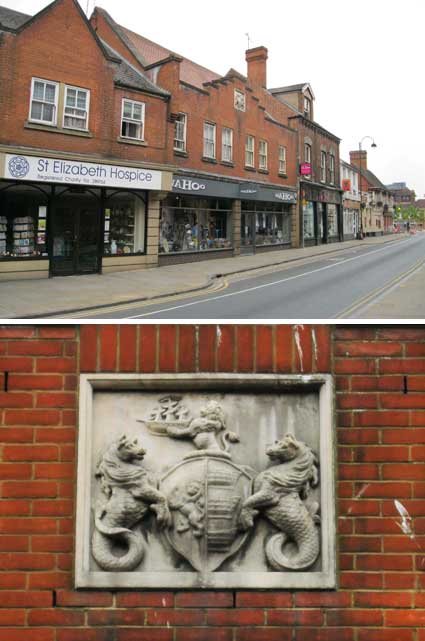 2013
images
2013
images
Next-door-but-one from the 'Edme Bakery' lettering at 8-10 Dogs
Head Street, this red brick frontage above the Wahoo shop features a
stepped rise in the centre featuring a rather nice stone Ipswich coat
of arms. The detailing of the cannon ports on all four ship hulls and
the scaley bodies and swirling manes of the 'sea horses' are striking.
As
at 40 Museum Street (above), we had assumed that this was once a local
government office. Below is a period photograph of this
(or a previous?) building showing not only the Borough coat of arms,
this time painted, at the apex, but also 'EDME
BAKERY' just visible on the eastern face of the next door building.
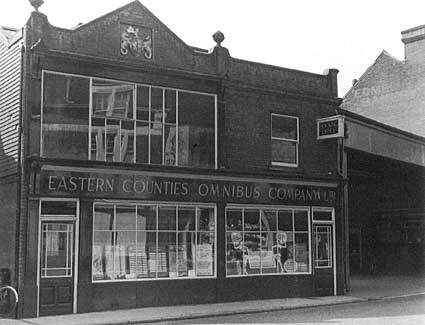
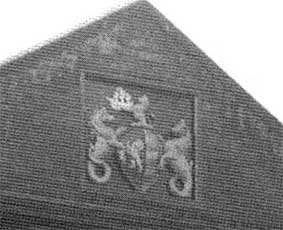
Eastern Counties Omnibus Company began operating from derelict
land near the old cattle market in the 1930s. Why are the Arms here? The
coat of arms actually relates
to The Ipswich Arms pub which occupied these premises. This
ancient public house is listed as both on Dogs Head Street or at 2
Lower Brook Street. If this photograph and the identification of The
Ipswich Arms at this location is correct then, Dog's Head Street it is.
This Ipswich Arms (as distinct from the pub of the same name in
London Road, now demolished and the site of a Lidl supermarket)
operated as
licensed
premises from the 1780s to around 1900. Many
of the buses arriving from Felixstowe and
Woodbridge areas would drive through the garage to the right of the
photograph in order to gain entry
to the Old Cattle Market bus station. The building beside the garage
was Eastern Counties booking and information office. The town coat of
arms relating to the former public house name can be seen in
the small brick gable. All of these buildings associated with Eastern
Counties have since been demolished, but the coat of arms was clearly
rescued (or another version made) and resited as we see it today above
the Wahoo shop.
Soane Street
/ Christchurch Park
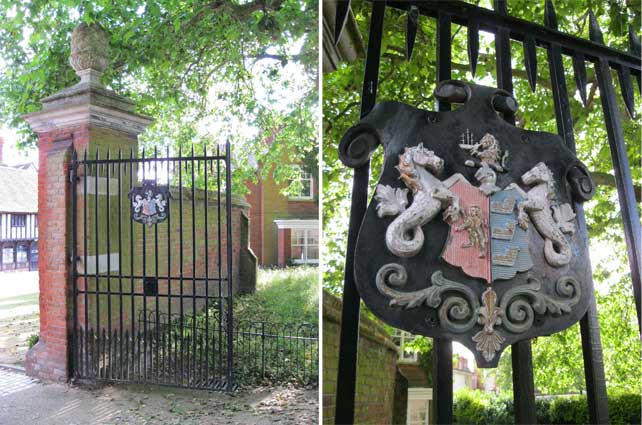
The main gates to Christchurch Mansion in Soane Street, with
pineapple finial and the old Packhorse Inn
in the background, carry a curly, nicely-painted metal version of the
Ipswich coat of arms.
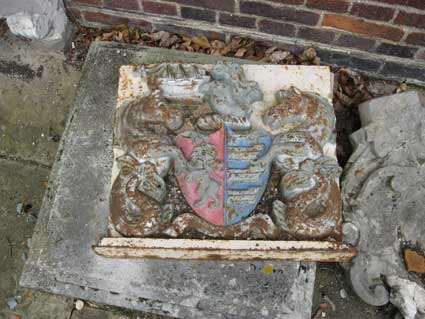
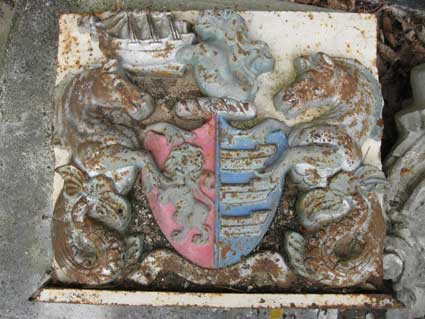 2014 images
2014 images
In 2014 at the rear of the Wolsey Gallery behind the Mansion we
stumbled across two chunky, heavy, cast iron Borough crests. The second
(upside down) example is missing its base and the upper corners of the
background rectangle. They are lying around with one or two
architectural details and column bases (see our Christchurch Mansion page for photographs
of these). If anyone knows where these
two, rather rusty and faded, crests were originally displayed, please contact us.
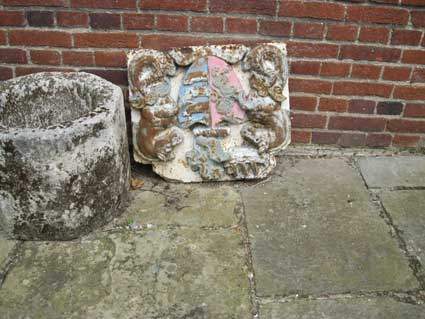
Ipswich Art
School, High St
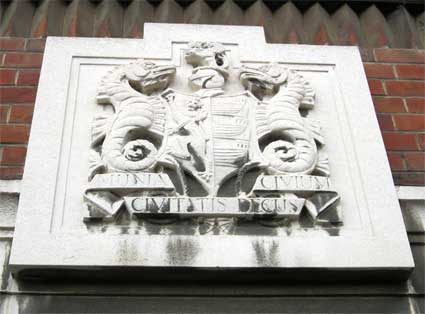
The bearers of the town arms above are definitely zoologically
correct sea-horses without forelimbs.
Ipswich County
Library
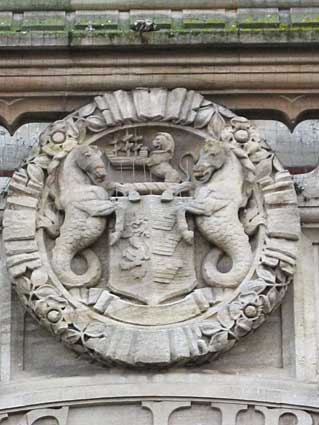
Here the Neptunes horses have their heads turned towards the
viewer; again, the armour helmet is missing.
The
Ancient House
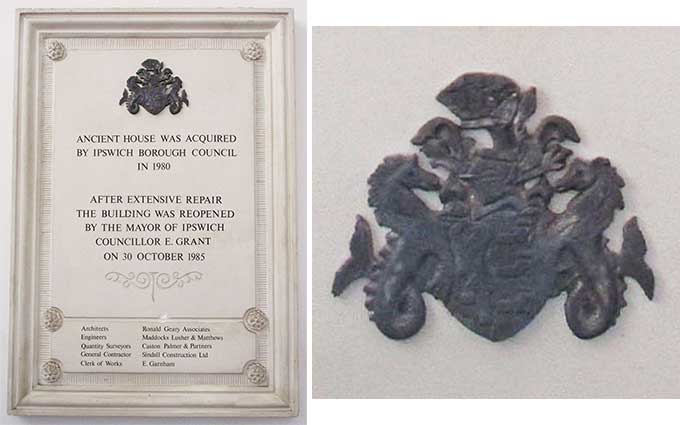 2023
images
2023
images
On the stairwell of The Ancient House, probably
Ipswich's most famous building, is an official Ipswich Borough Council
plaque commemorating the acquisition in 1980 and remarkable rescue work
and refurbishment which saved this building for the nation. It features this metalwork Borough coat of arms. The
occupants of The Ancient House were Hatchards, the booksellers, who had
to move all their stock and fittings into a property in Upper Brook
Street while the work was being done. The building reopened in 1985.
Custom House
Possibly the biggest, most three dimensional (and hardest to
see) Borough coat of arms in the palladian apex of the Wet Dock Custom
House. Note how deep the recess is.
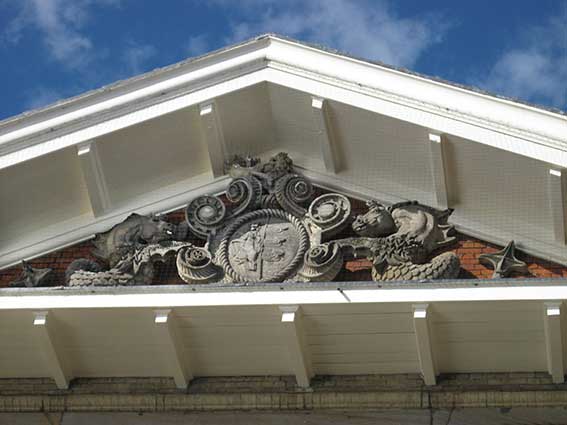
Lots of curling scrollwork surround the crest; again, the armour
hemet is missing, the upper ion and ship emerging from the swirls.
Although not visible above, the crest and supporters sit on a base
resembling dry stone walling which suggests the sea.
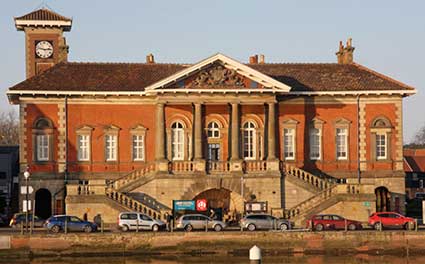
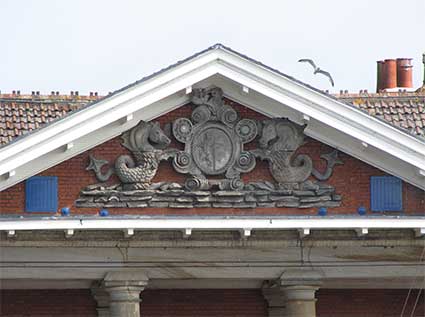
The above photographs courtesy Tony
Marsden.
Anglesea Road
Hospital
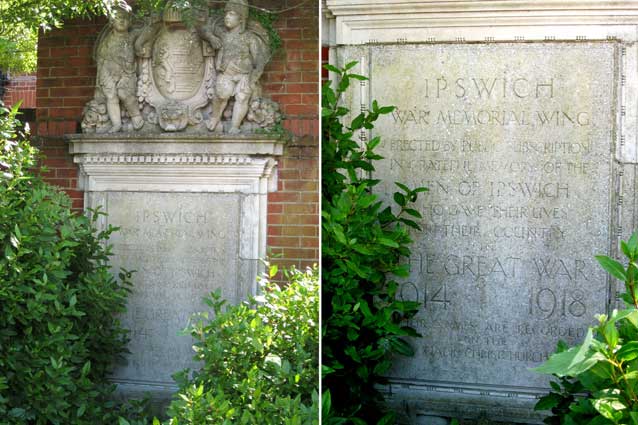
Here the arms of the town are supported by two cherubic figures.
Argyle
Street School
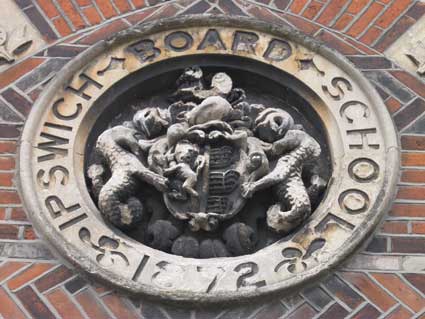
Well, it's seen better days... stained and battered, but
recognisable.
Gatacre
Road School
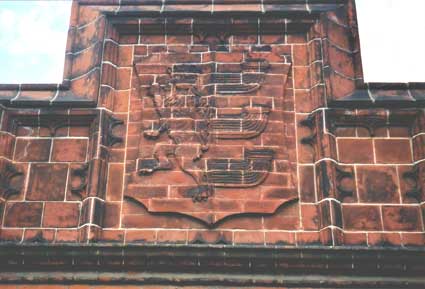
The arms without the supporting sea horses and upper lion
holding a sailing vessel.
Springfield
School
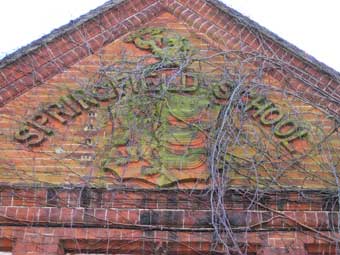
Often hidden by algae and creeper, this is a fine piece of relief
brickwork; the arms without the supporting sea horses.
Ranelagh
Road School
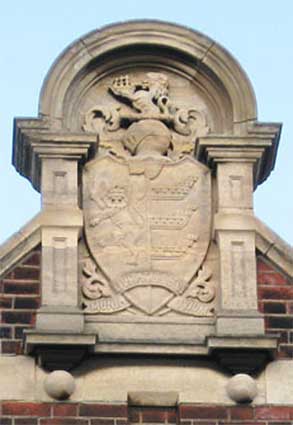
The arms without the supporting sea horses, but with the crest
above.
The scroll beneath reads: 'MUNIA CIVITATIS DECUS CIVIUM' ('The
functions of citizenship are the glory of the citizens'). This also
appears on the Ipswich Art School version in High Street.
Bourne Bridge
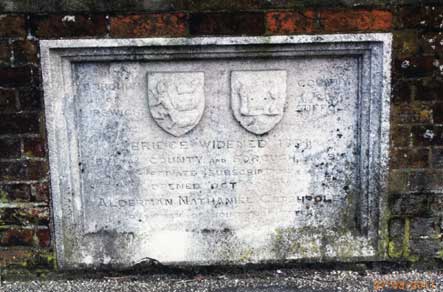 Photo courtesy: Mike
O'Donovan
Photo courtesy: Mike
O'Donovan
The arms (upper left) without the supporting sea horses.
The shield to the right bears the castle emblem of East Suffolk County Council.
Park Road Reservoir
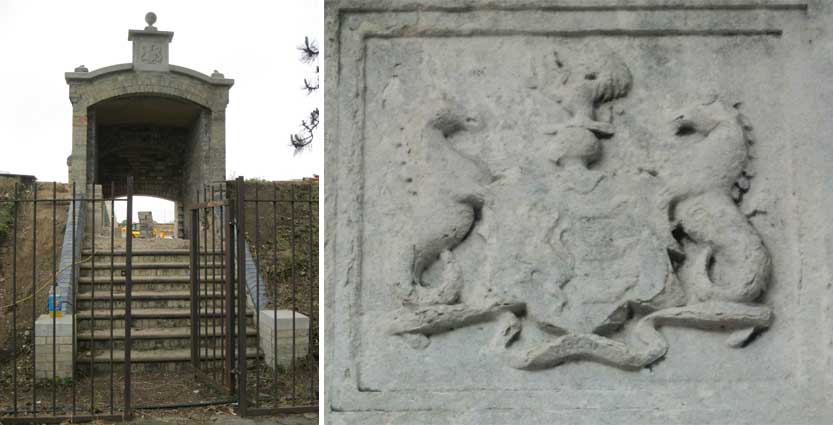
During the partial
demolition and re-landscaping of the
site during 2013, this original entrance was noticed (partially bricked
up for many years). It bears the town coat of arms in a very eroded
condition on a stone block with ball finial
atop it. This presumably dates back to days of the Ipswich Corporation
Water Works as commemorated on one or two hydrant covers in the town's
pavements and in the road name: Waterworks Street.
Tooley Almshouses
Only discovered by this website on Heritage Open Day,
2015, is this fine rendition in coloured relief of the coat of arms
above the entrance facing the main porch.
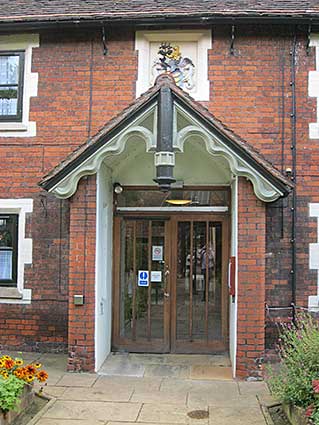
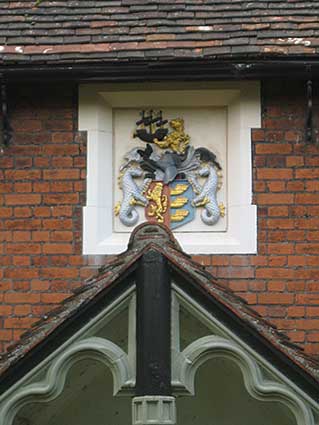
Crown Pools coat of arms
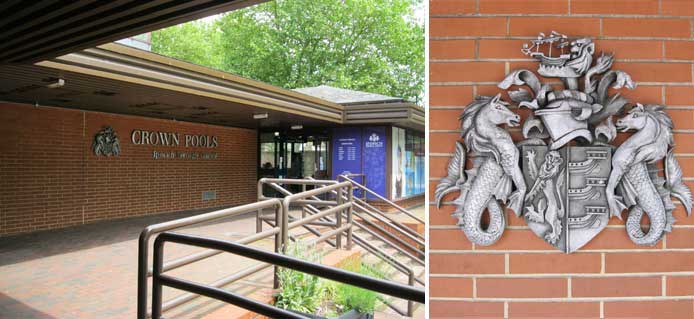
One of the more recent version of the coat of arms to be found
in the town, at the entrance to Crown Pools, Crown Street.
Vernon Street
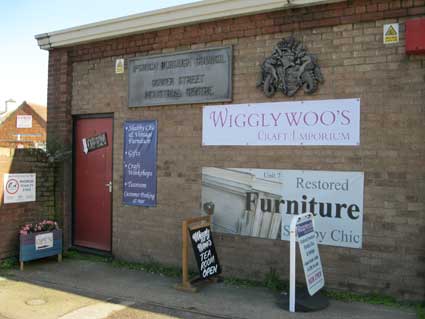 2014 images
2014 images
Once worth a large nameplate and three dimensional coat of arms
(even though the door is on Vernon Street), this building, as so often,
is now something else:
'IPSWICH BOROUGH COUNCIL
GOWER STREET
INDUSTRIAL CENTRE'
We do not know what this 'industrial centre' consisted of;
needless to say, it's home to commercial companies these days. A
similar relief version of the Borough coat of arms can be seen on
Crown Pools (shown above).
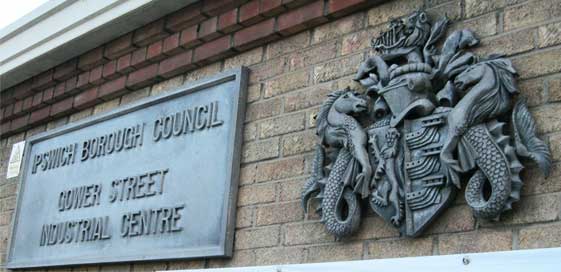
Cliff
Lane Almshouses
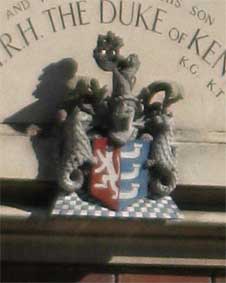
Three-dimensional, picked out in red, white and blue and now
with added chequerboard base, this crest is small and easy to miss (we
did) at the foot of the 1938 Cliff Lane
almshouse memorial tablet.
Grafton House
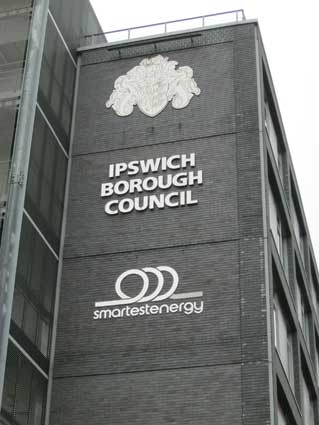
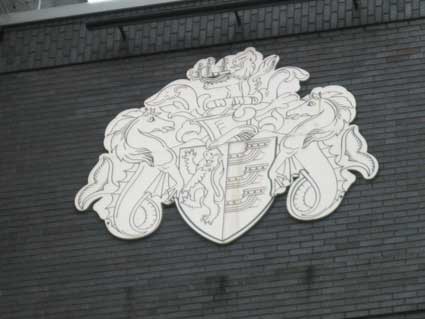
Inevitably, the home of Ipswich Borough Council,
Grafton House in Russell Road – since the move from and demolition of
Civic Centre – should be included here, even though the metal coat of
arms resembles a colouring-in plate from a children's book. The screws
fixing it high up on the side wall of Grafton House are beginning to
rust. Civic Drive features street
nameplates with the coat of arms and labelled 'County Borough of
Ipswich' – but all semi-obliterated.
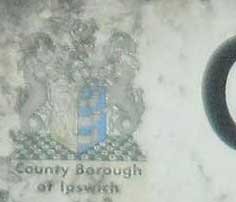 Civic Drive sign
Civic Drive sign
For emblem and coat of arms of East Suffolk County Council see our County Hall page.
Willis
obelisk
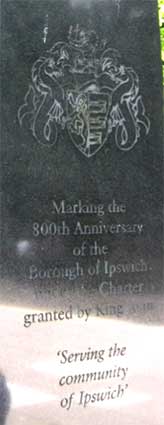 800 years
since the Ipswich Charter
800 years
since the Ipswich Charter
Modern steel street signs often
incorporate the Ipswich coat of arms.
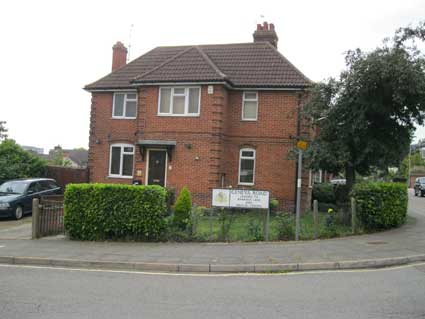
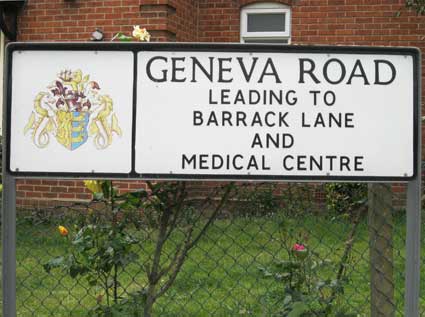
This example at the top of Geneva Road has fared better than
many. The coloured emblem has a tendency to fade away over the years,
probably due to the action of the sun. The coat of arms
in the left hand box is the one shown at the top of this web page.
 See
also our Spread Eagle page for an
unusual configuration of street name and coat of arms.
See
also our Spread Eagle page for an
unusual configuration of street name and coat of arms.
The Tooley brass
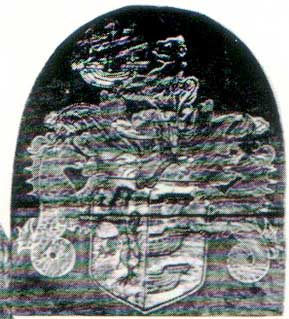
Above: a rubbing detail from the brass memorial to Henry Tooley,
his wife and family shows at the top a version of the Borough coat of
arms.
The Golf Hotel
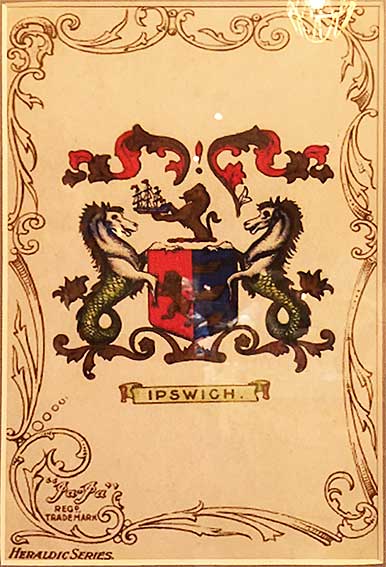
Seen
framed on the wall of the bar in The Golf Hotel on Foxhall Road, this
early 20th century, slightly fantastical version of the coat of arm
bears the word 'IPSWICH' on the scroll beneath. Neptune's horses seem
quite please to be there and the upper lion (bearing the masted ship)
has an excalmation mark above its head, as if he was a surprised
character in The Beano.
[UPDATE 14.1.2021: Peter
Durrell of the Suffolk Heraldry Society tells us: 'The picture of the
arms in The Golf Hotel is a Ja-Ja Postcard published as part of a
series covering the whole country.'] Thanks to Peter
for pointing this out. Within the corner curlicue at the lower left we
can see: "Ja-Ja" Regd. Trademark – HERALDIC SERIES. Heraldic postcards
(and presumably larger prints, as shown above) using the trade mark
Ja-Ja were issued by Stoddart & Co, Halifax, West Yorkshire,
England. The company was established in 1905, but had ceased publishing
postcards by 1917.
ITFC
Almost sixty years after its founding, Ipswich Town Football
Club
turned professional and joined the Southern League
in1936. The old striped shirts
were replaced with smart new blue ones with white sleeves, complete
with a club crest, basically the town's coat of arms. (The
modern club crest shows a Suffolk punch horse.)
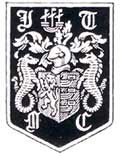
Buses and trams
Ipswich Transport Museum
features some fine examples of public transport livery of yore and we
show below a restored version of the Ipswich coat of arms on an
electric
tram body.
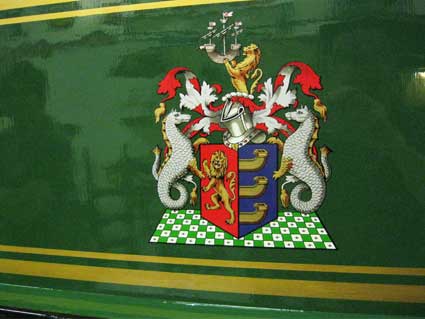
Ransomes
& Rapier medal
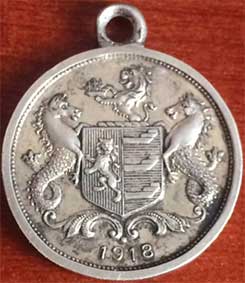
Ransomes' traction engine transfer
(detail) shows a rather eccentric interpretation of the coat of arms.
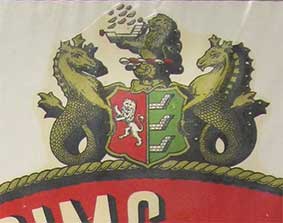
Ipswich Dock Commission
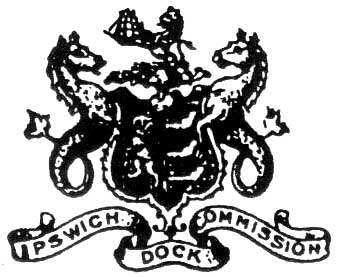 Courtesy
Ipswich Maritime Trust
Courtesy
Ipswich Maritime Trust
In 1837 an Act of Parliament allowed the Ipswich Dock
Commissioners to construct the new Ipswich Wet Dock, to be the largest
enclosed dock in the country. The Ipswich Dock Commission was provided
with investment of £25,000 and the right to borrow a further £100,000;
but it needed a further loan of £20,000 and also an additional levy of
six pence per tonne on all imported coal to fund the project. The
Ipswich Dock Act 1971 authorised the development of the West Bank to
allow roll-on roll-off ships to dock. The Ipswich Dock Commission was
reconstituted as the Ipswich Port Authority in 1973.
The Borough Arms used by local sports
clubs...
Thanks to Peter
Durrell of the Suffolk Heraldry Society for pointing out these examples.
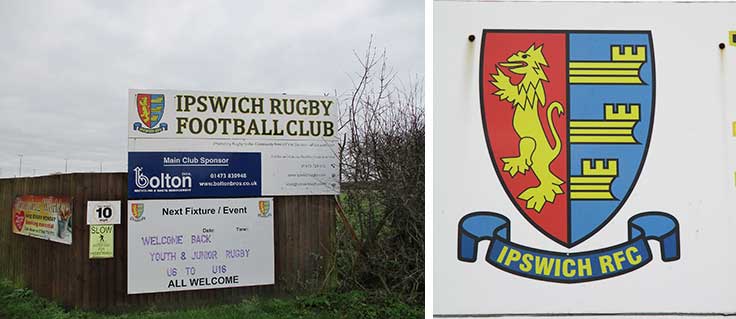
Above: the entrance on Humber Doucy Lane to Ipswich Rugby Club
features a modern take on the Borough Arms with accompanying scroll:
'IPSWICH RFC'. No sign of the moveable rudders on the
ships' sterns.
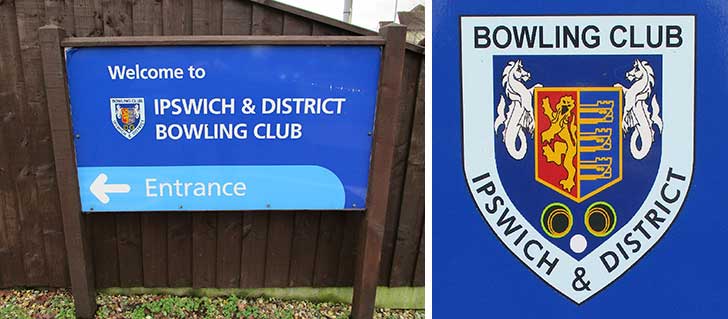
Above: the entrance on Rushmere Road to The Ipswich &
District Bowls Club (indoor bowls ans greens) displays an adaptation of
the Borough Arms and Supporters, albeit squeezed into a shield shape.
There is even room for two bowls and a jack below.
... and a furniture-maker
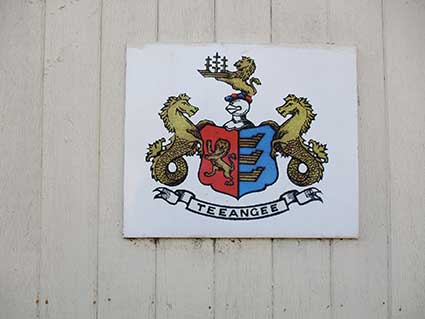 2021
images
2021
images
Titchmarsh & Goodwin has a long pedigree in Ipswich(§),
their
furniture works being located in Back Hamlet, behind Trinity Lodge – which the company
once owned. They have adopted the
Borough arms and cheekily placed 'TEEANGEE' on the scroll
beneath. On the office building is a three-dimensional coat of arms
with: 'Est. 1920' on the scroll.
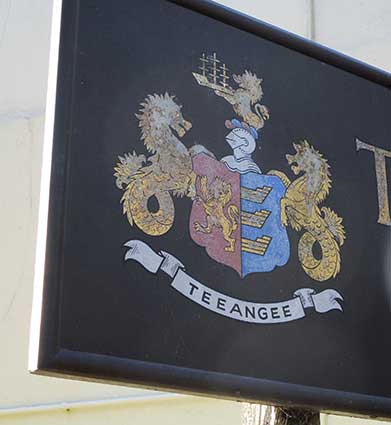
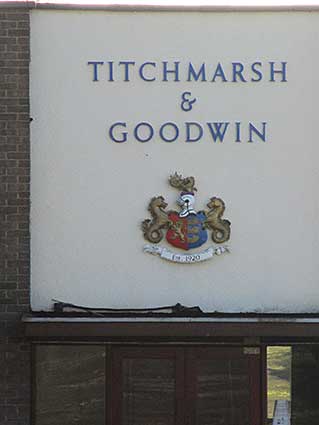
(§)For more on the story of the cabinet makers in Back Hamlet
see From
mighty oaks ... came Gordon Goodwin's dream and Trinity
Lodge aka 'The Mansion House' on The Ipswich Society website.
[UPDATE Spring
2021: during a post-pandemic-lockdown walk, we came across the
long-abandoned Witnesham Saw Mills site on Mow Hill, walking from Wash
Lane towards The Barley Mow public house. The old, weathered sign-board
reveals that the saw mills were owned by Titchmarsh & Goodwin and
has a subtle 'TEEANGEE' Borough crest between 'Cabinet' and 'Makers'.]
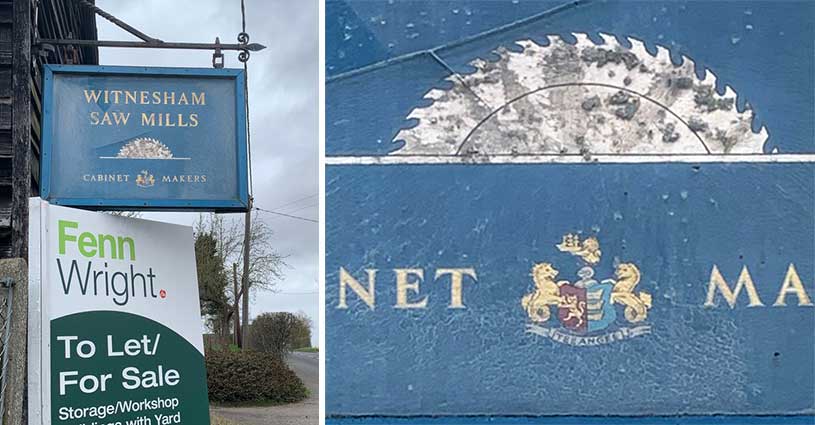 2022 images
2022 images
Ipswich coin 1794
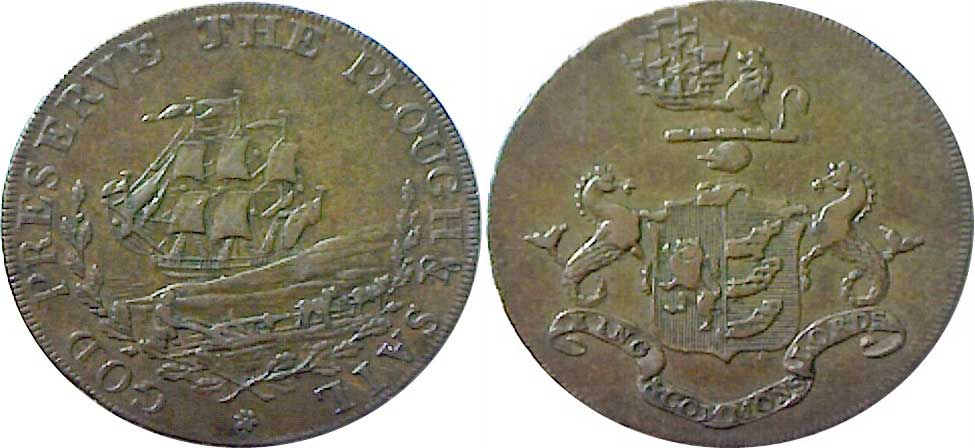
[UPDATE 13.3.2017: Collector, Michael Sykes, has kindly sent
the above images:
'Hello, I saw your page. I have a 223-year-old token of 1794
with the crest on. It is not on your page. I attach images of both
sides. It has a catalogue (Dalton & Hamer) reference of DH#34 and
has lettering of "PAYABLE AT ROBERT MANNINGS IPSWICH . X X
." on the edge. The motto "KINGS... LORDS...
&
COMMONS" is below the crest on a ribbon. I am in Bedford
but
bought the token as I liked it; you can use my images.' For those of us who know little of coins
and their history, it’s perhaps a surprise that in 1794 words were
being inscribed round the edge of a coin. We would guess that most
people first saw this feature on the modern one pound coin. The
lettering around the galleon and ploughman with his team is 'GOD
PRESERVE THE PLOUGH & SAIL'
highlighting these major contributors to economic wealth and power –
those two elements appear as the name of the public house at Snape
Maltings: The Plough & Sail.
See also
the Ipswich farthing, 1670
found at the St
Mary-At-The-Quay archaeological
dig.]
N.B.: The Ipswich Mint 'Ipswich
was an important commercial centre and it is almost certain
that some of the silver coins (series R sceattas) of the early 8th
century were minted in Ipswich. The first silver pennies with the names
of East Anglian kings from Beonna onwards , which bear the names of
moneyers Efe and Tilbert under King Beonna, c.758, and Lul under King
Ethelbert, c.792, are also likely to have been minted in the town.
These moneyers were doubtless men of some status and they might be the
first English residents recorded by name.'
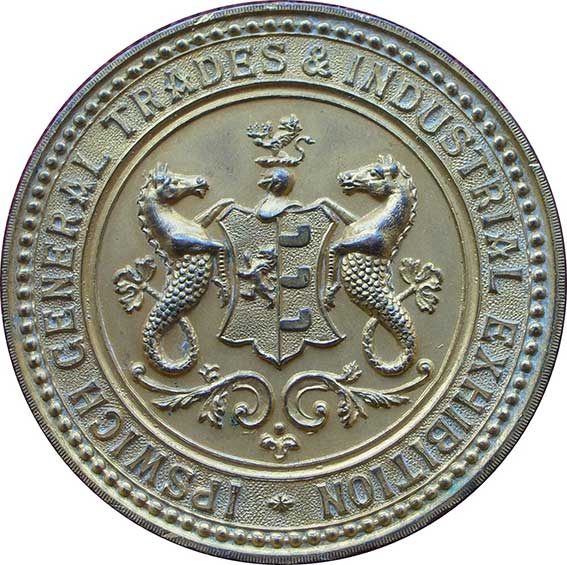
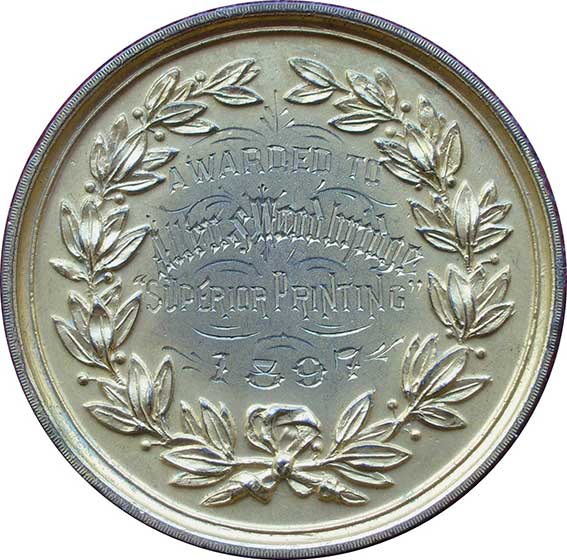
[UPDATE 1.9.2018: 'I have
attached two pictures of a nice medal (engraved 1897) you might also
want to add. Sadly I did not win it last night - I got outbid and it
sold for £30 so I do not own it, but hopefully copyright does not
affect the rights. I think the lettering is:
Front: IPSWICH GENERAL TRADES & INDUSTRIAL EXHIBITION *
Back - engraved: 'AWARDED TO Allen & Woodbridge "SUPERIOR
PRINTING" 1897'
Thanks! Michael Sykes. Thanks to
Michael; the simplified version of the Ipswich coat of arms looks a bit
empty here.]
And another Ipswich coin...
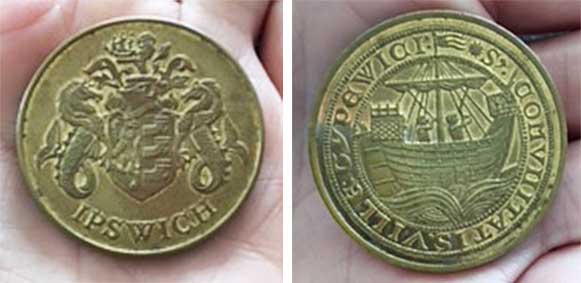
[UPDATE 16.3.2018: 'I collected
coins as a young boy and after collecting dust for 35 years I had a
look at them and found this coin. I came across your site whist
trying to investigate its origins. If you know anymore about the coin
that would be great? Kind regards, Michael Durrant.' Many thanks to Michael for these images.
If anyone can shed light on either the coin and irs history, do email
us
on the link at the foot of the page.]
[UPDATE 30.11.2018: Another
fine example from Michael Sykes: 'I bought this lovely medal the other
day,
if you would like to add it to your site. It is 38mm diameter and
5mm thick, and comes in a hinged case 57mm square. This medal is as
made (it has never been engraved on the back). Not sure when it dates
from. Lettering on front: 'IPSWICH & DISTRICT PHOTOGRAPHIC
SOCIETY'. The stylization in the
design suggests that this is a 20th century medal, perhaps. The
Neptune's horses and lion holding the ship are decidedly slimmed down,
as is the lion rampant on the shield as so often, the ship's rudders
are missing.]
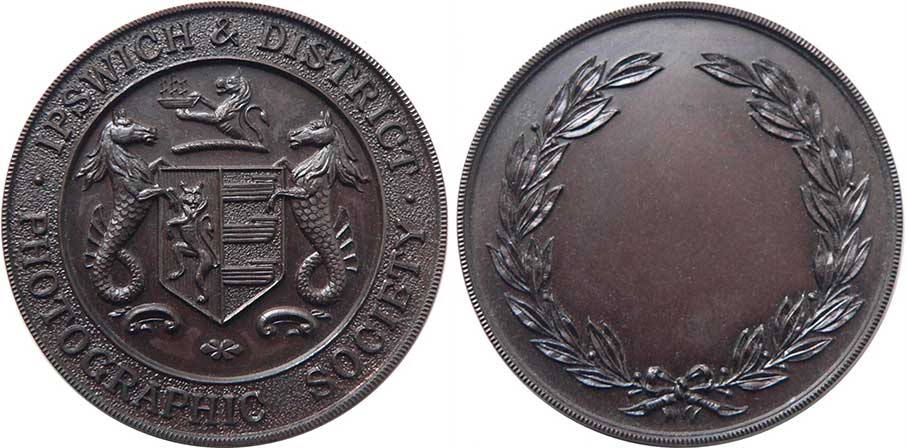
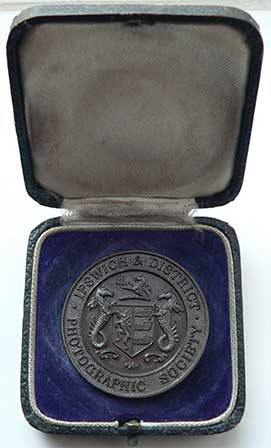
[UPDATE 30.12.2018: 'I attach
the history of the medal that is held in the Society archive, together
with images of the two medals mentioned. I do hope that I have
furthered your interesting research into the variety of Ipswich coats
of arms, a subject I had not thought of before! Diana
Freeman, Archivist of IDPS. Many
thanks to Diana for adding this information to the website: all
fascinating material.
'Ipswich & District
Photographic Society
The title ‘Ipswich and District Photographic Society’ came into being
in 1928 when the photographic section broke away from the Ipswich
Social Settlement Club. There was another club called Ipswich Camera
Club that appears to have been formed in the 1880s and ran in parallel
with the Social Settlement group. Probably this camera club had a
membership identical to the Social Settlement group as photography is
so specialised/localised. We have one medal of theirs dated 1905
awarded to J. Ludlum for a Lantern slide in an ‘open’ competition (see
below).
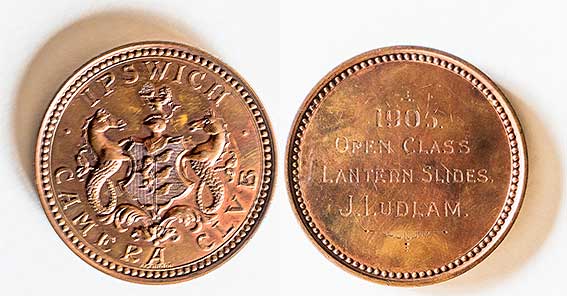
'From the I.D.P.S. minute
book of 22 October 1928 there is a mention of J.W. Hood and Co.
offering to cut a die for the Society free of charge if there were
orders for the medals. The Committee agreed to accept the offer.
To begin with only four bronze and one silver medal were awarded
annually, later rising to one silver and 8 bronze. There is no
indication in the Minutes as to how many medals were ordered to begin
with so there may be other ‘blanks’ out there somewhere. It is also not
clear if they were all engraved. The odd Account records we have only
record cost of engraving for silver Cups.
However there is one bronze medal that we know was engraved. It
is featured on a vintage medals website and was awarded to S.H. Rivron
in 1938, this is identical to the one you enquired about.
Now the coup d’etat: we have the die for it ! It is 5.3 cm in
diameter by 5 cm tall (including the raised surface with the die
impression).
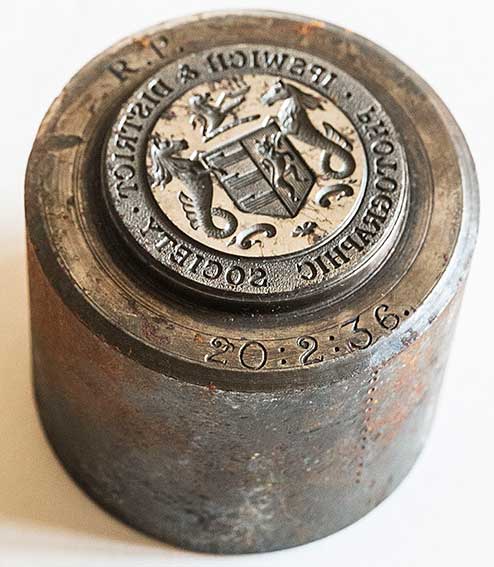
'The only doubt we have as to its maker is the fact that, as you will
see, it is incised ‘R P’ on the edge above the
engraving and ‘20:2:36’ below. Which doesn’t tally with J.W. Hood
unless R P are the initials of the worker who actually made the die and
the other numbers are not a date but die maker’s record numbers.
If you know anything about J.W. Hood & Co. I would be very
interested to include the information in the Club records.']
Arras, France
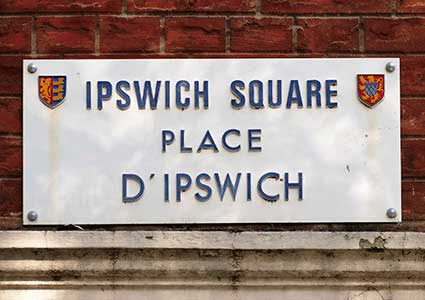
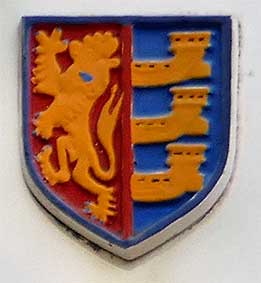 2018 images
courtesy David Gaylard
2018 images
courtesy David Gaylard
The importance of the twinned town relationship (although not
technically 'twinned', we hear) between Ipswich and
Arras in northern France is illustrated by this street nameplate in
Arras. It
embodies the Ipswich Borough coat of arms and that of the City of
Arras. The history of Arras, going back to the Roman period,
bears striking similarities with the history of Ipswich – not least in
its prominence in the wool trade. Given its
geographical position, Arras was the epicentre of military engagement
in bothe the First and Second World Wars.
See our Blue plaques page (under Other plaques) for the equivalent
Arras Square street nameplate in Ipswich.
Railway armorial
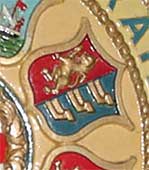
The Ipswich coat of arms also appears on the Great
Eastern Railway armorial to be seen in the Church
of St Mary-At-Stoke.
Home
Please email any comments
and contributions by clicking here.
Search Ipswich
Historic Lettering
©2004
Copyright
throughout the Ipswich
Historic Lettering site: Borin Van Loon
No reproduction of text or images without express written permission
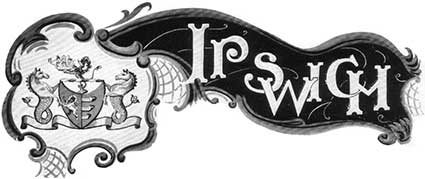





 13th Century Seal of Ipswich
13th Century Seal of Ipswich
 Image
courtesy Peter Wonson
Image
courtesy Peter Wonson 2018 images
2018 images


 Shield with the arms of the Borough of
Ipswich.
Shield with the arms of the Borough of
Ipswich.
 Image courtesy Taff Gillingham
Image courtesy Taff Gillingham 1932
1932
 1934
1934
 1934
1934 2025
image
2025
image 1906
1906






 2013 images
2013 images 'IPSWICH COUNTY COURT'
'IPSWICH COUNTY COURT' 2018
images
2018
images

 2019
images courtesy Simon Farr
2019
images courtesy Simon Farr 2018 image
2018 image
 Next to the Temple of Remembrance, Ipswich 'New
Cemetery'.
Next to the Temple of Remembrance, Ipswich 'New
Cemetery'. 2022
image
2022
image 2014
image
2014
image
 Photograph
courtesy JohnNorman
Photograph
courtesy JohnNorman 2014 image
2014 image  Courtesy
John Norman
Courtesy
John Norman 2013 image
2013 image 2018 images
2018 images

 2013 images
2013 images

 2013
images
2013
images


 2013
images
2013
images Cinque
Ports coat of arms
Cinque
Ports coat of arms 2013
images
2013
images



 2014 images
2014 images


 2023
images
2023
images







 Photo courtesy: Mike
O'Donovan
Photo courtesy: Mike
O'Donovan



 2014 images
2014 images



 Civic Drive sign
Civic Drive sign 800 years
since the Ipswich Charter
800 years
since the Ipswich Charter

 See
also our Spread Eagle page for an
unusual configuration of street name and coat of arms.
See
also our Spread Eagle page for an
unusual configuration of street name and coat of arms.





 Courtesy
Ipswich Maritime Trust
Courtesy
Ipswich Maritime Trust

 2021
images
2021
images 

 2022 images
2022 images








 2018 images
courtesy David Gaylard
2018 images
courtesy David Gaylard